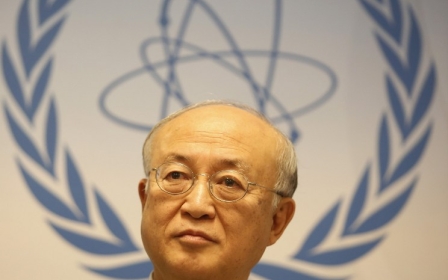IAEA: Iran addresses nuclear bomb allegations for first time
Iran has for the first time in six years addressed concerns about the so-called "possible military dimensions" of its nuclear programme, a new IAEA report showed Friday.
Tehran handed over information related to detonators that can be used for several purposes but also for a nuclear weapon under a key November interim nuclear deal, the quarterly report, seen by AFP, showed.
The report comes a week after a fourth round of talks between Iran and the P5+1 in Vienna, which ended with no apparent progress towards a comprehensive deal over Tehran's nuclear programme.
Failure to reach a deal by 20 July could spark a conflict - neither Israel nor the US have ruled out taking military action - and set the stage for a nuclear arms race in the Middle East.
Iran's President Hassan Rouhani insisted on Thursday however that a timely deal by the end of July was "very likely."
Stay informed with MEE's newsletters
Sign up to get the latest alerts, insights and analysis, starting with Turkey Unpacked
Resolving the nuclear dispute - and the economic-related problems caused by sanctions - is the Rouhani administrations biggest challenge, yet one the president and his team have embraced, Iranian political analyst Mahan Abedin wrote for the MEE this week.
Despite the administration's enthusiasm, Abedin said, it has clear red lines including Western demands to dismantle nuclear-related facilities and to curtail the country's ballistic missile programme.
"Success in the next rounds will largely depend on the extent to which both sides can step back from their maximalist positions to allow for common ground to take shape," he said.
Iran sticks to commitments
In technical meetings with the UN atomic watchdog in late April and earlier this week in Iran, Tehran provided "information and explanations, including showing documents, to substantiate its stated need and application of EBW (Explosive Bridge Wire detonators)," the report by IAEA director-general Yukiya Amano for member states said.
Such fast, high-precision detonators could be used in civilian applications, but are mostly known for triggering a nuclear chain reaction. The IAEA believes they form "an integral part of a programme to develop an implosion type nuclear device."
In a 2011 report, the IAEA said that Iran had told the agency that it had developed EBW detonators for civil and conventional military use. But Iran had not, at that point, explained its need or application for the detonators, the report said.
But in the quarterly report seen by AFP, Iran showed that EBW firing was used for a civilian application.
"This is the first time that Iran has engaged in a technical exchange with the agency on this or any other of the outstanding issues related to possible military dimensions to Iran's nuclear programme since 2008," the report said.
The EBW issue was part of seven "practical measures" that Iran agreed with world powers under a November interim deal and due to be fulfilled by 15 May.
All have been implemented, the International Atomic Energy Agency said in its report, indicating that Iran was sticking to its commitments.
Tehran agreed in November with the so-called P5+1 powers -- the permanent members of the UN Security Council plus Germany -- to roll back its nuclear programme to make it virtually impossible to make an atomic bomb in exchange for some relief from biting international sanctions.
The "possible military dimensions" of its nuclear programme have been of concern to the international community for years.
In November 2011, the IAEA reported it had intelligence that Iran had until 2003 and possibly since then conducted research into developing nuclear weapons. Iran on the other hand insists its nuclear programme is merely for peaceful, civilian purposes.
Uranium stockpile being converted
Under the November deal, Iran also agreed to convert and dilute its entire stockpile of medium-enriched uranium, making it more difficult to quickly produce the weapons-grade material needed for a bomb.
Of this stockpile, 38.4 kilogrammes of 20-percent enriched uranium was still awaiting conversion -- down from 160.6 kg in February -- the report said.
Iran has until 20 July to complete this work.
The enrichment programme otherwise remains frozen, with no uranium enriched to levels above five-percent and no new centrifuges installed at its enrichment facilities, the IAEA found.
Enriched uranium can be used to make nuclear fuel but also to make the core of an atomic bomb.
A senior official close to the Iran dossier said Friday that it was "still too early" to say if the latest information provided by Iran - including on the detonators - was credible, but welcomed the atmosphere during discussions between the UN agency and its member state.
"We have a lot of new information, which is a good thing... the engagement and cooperation has been improving all the time. In that respect that's a positive development and a positive step forward."
For Kelsey Davenport of the Arms Control Association, a Washington, DC-based organisation dedicated to promoting public understanding of and support for effective arms control policies, the IAEA report showed "that Tehran is fulfilling its obligations and willing to be more transparent about its nuclear activities."
Middle East Eye delivers independent and unrivalled coverage and analysis of the Middle East, North Africa and beyond. To learn more about republishing this content and the associated fees, please fill out this form. More about MEE can be found here.




